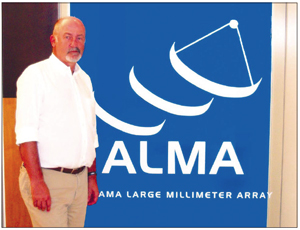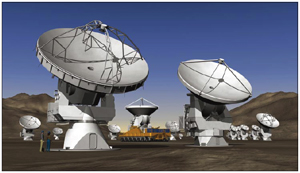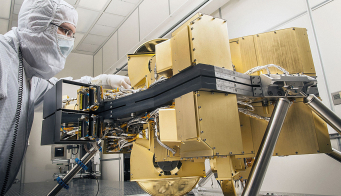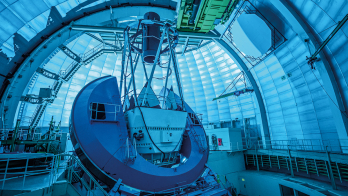The director of a new large-scale radio telescope explains its goals.

Image credit: Paola Catapano.
Massimo Tarenghi has been described as “an excellent scientist and an energetic manager” by physics Nobel laureate Riccardo Giacconi, his colleague and fellow pupil of Beppo Occhialini. Tarenghi had wanted to be an astronomer since childhood. He graduated from the University of Milan with a degree in theoretical astrophysics, plus a thesis on gamma radiation from the galaxy core. In Arizona he took part in the first research work on large-scale galaxy distribution. He returned to Europe to lay the foundations of the European Organization for Astronomy in the Southern Hemisphere (ESO) at CERN, where ESO had its first offices.

Like Giacconi, Tarenghi is a pioneer of the first large telescopes. He put forward the idea of building ESO’s Very Large Telescope (VLT) and directed the project from 1986 to 2002, commuting from ESO’s eventual premises in Garching, Germany, to the telescope’s site in the Paranal desert in Chile. He was appointed director of the Atacama Large Millimetric and Submillimetric Array (ALMA) in 2003, which is under construction in northern Chile on the Chajnantor plateau of the Atacama desert, the highest desert in the world. ALMA is a radio telescope made up of 64 antennas over an area of 25 km2 at an altitude of 5100 m.
As we climb by jeep from the Operation Support Facility (OSF), ALMA’s base camp at 2900 m, to the construction site at 5100 m, Tarenghi tells us: “When ALMA is ready in 2010, it will be to astronomers the equivalent of the LHC to particle physicists.” ALMA will be operated from the OSF, which will also house offices and laboratories. The ALMA assembly hall and the control room to operate the telescopes remotely are under construction. The circular structure of the buildings echoes the Atacameno architecture, honouring the 20,000 indigenous population who have lived in this extreme environment for 10,000 years. They will be given free access and job opportunities on the ALMA site.
By late August, three of the antennas had been shipped to Chile from Japan. Assembly and adjustment is taking place in the assembly hall, with the first of the three expected to be installed on the Chajnantor site before the end of the year. “Most of the work after commissioning will also be done here, just below 3000 m, which is surely more comfortable than above 5000 m, where there is 50% less oxygen in the air. It is also more convenient from a legal point of view,” says Tarenghi.
Before leaving the OSF, we went through medical screening to check blood pressure and oxygen levels and we collected oxygen bottles for the trip. With the magnificent background of the snow-capped Licancabur and Lascar volcanoes, the road to Chajnantor winds up through the Atacamenos archaeological sites and past examples of Echinopsis atacamensis, a rare protected species of centennial cacti that grows up to 9 m tall and only at altitudes of 3200 – 3800 m. The exceptionally flat access road is 20 km long and 12 m wide. It was built specially to enable the smooth transportation of the 64 antennas from the base camp to the Chajnantor site. The builders had to go around the cacti and archaeological remains to leave them untouched.
After stopping a few times to adjust to the altitude, we reach the ALMA site at 5100 m, and admire the view, which was literally breathtaking. The site has been chosen because of its ideal conditions for radio astronomy. Being isolated guarantees the total absence of other radio signals from human communications. The lack of humidity, which would otherwise absorb the millimetre and submillimetre emissions that ALMA is designed to catch, is also important. Tarenghi explains: “Most of the energy of the universe is made of the millimetric and submillimetric radio waves that ALMA is specialized in. In this area of the electromagnetic spectrum, half of the stars in the universe are formed inside intergalactic dust, which makes them invisible to optical telescopes. Here interesting astronomical phenomena take place, such as the birth of new stars and galaxies, immediately after the Big Bang. ALMA will be able to tell 90% of the history of the universe, which we still do not know. Moreover, in the submillimetric radio waves organic molecules are found, such as carbon and sugars. They are the origin of life in space, far from the Earth.”

The remarkably flat access road to the remote Chajnantor site (top) passes rare species of centennial cacti.
Image credit: Mike Struik.
On the Chajnantor we reach the Atacama Pathfinder Experiment (APEX), the first antenna installed on the ALMA site in 2004. It has a disc of 12 m diameter and weighs 120 tonnes. “APEX already obtained an important result in August 2006. It found fluorine, the first organic molecule to be found in the intergalactic dust of the Orion Nebula – a nice start that shows the scientific richness of this area of the spectrum. We have all the more reason to expect spectacular discoveries after 2010,” Tarenghi tells us.
In 2010 the site will be covered by 64 antennas similar to APEX, made in Europe, Japan and the US. Their signals will be combined by interferometry, making a combined radio telescope as big as the distance between two antennas. The site will have 197 concrete platforms to enable astronomers to lay out the 64 antennas according to their needs. The “compact” configuration, with a 150 m diameter around the centre of array (COFA), will be used to observe a slice of the sky at the maximum resolution (20 μm). The large array with a 3 km diameter will enlarge the visual range exactly like the zoom of a camera. (An array of diameter more than 10 km is also under construction) Tarenghi adds: “ALMA will be like Hubble on Earth. It’s a unique effort by Europe, the US and Japan. Like VLT, ALMA is different from other observatories not just for the size and number of telescopes in the array, but because it was designed from scratch as an astronomical research machine with all the telescopes being part of a large unit – like the accelerator complex at CERN, in a way.”
As former director of the VLT, Tarenghi can uniquely explain how the two projects differ. “VLT looks at the hot universe, ALMA is specialized in the cold universe. The difference is enormous. ALMA will explore areas that are not accessible to optical telescopes. In the millimetric radio waves, luminosity decreases and in the cold areas you have clouds, dust, disks where entire planetary systems are formed around stars. ALMA will be able to see the first galaxies in the universe as they were born around 14 billion [thousand million] years ago,” says Tarenghi.
He also explains to us why ALMA will be able to see the origin of life in space. The submillimetre region that ALMA specializes in is also the area where organic molecules are born and where planets form around other stars. ALMA will detect the emission of the atmospheres of other planets and will be able to find the presence of life. “Through the physical and chemical analysis of the atmosphere, ALMA will detect the presence of water, find out when dust grains formed and reconstruct the molecular history of the universe,” he says. “It will map the presence of water to the extreme limits of the universe and stand the highest chance, compared with any other instrument, to find life on other planets.”
The real innovation that ALMA will bring about is a radical change in the way astronomers work. “ALMA will be an all-rounder, an observatory open to all astronomers, irrespective of their specialization,” says Tarenghi. “Instead of sharing observation time, astronomers will have access to ALMA’s data. Like LEP or the LHC, ALMA will provide access to scientific data that can be used by the entire community, including theoreticians who want to test a theory. This is a huge new step in astronomy.”
The goals of ALMA reflect the challenges in astronomy today. Tarenghi tells us: “We are ignorant of the way planetary systems are formed, we do not know how the first objects were formed and what they looked like, what is the birth rate of stars in the universe. We know the first galaxies were made of just hydrogen and the second generation of heavier elements, but the process that gave origin to the formation of planets was born from a sequence of birth and death of stars that we do not know with accuracy. Only by going to large distances with telescopes that can perform both a physical and chemical analysis, we will be able to understand the mechanism that formed stars and reconstruct the history of the stars’ birth rate.” Investigating dark matter and energy are also challenges for ALMA, and are shared with experiments at the LHC. “These phenomena require a detailed knowledge of the large-scale structures of the universe. Only instruments like ALMA and telescopes like VLT, which can reach the limits of the warm universe, will give us an idea, as they can provide more data from different observation sources,” concludes Tarenghi. It seems that ALMA, like the LHC, is set to give us a much clearer view of the nature of the universe.








